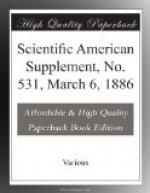(To be continued.)
* * * * *
COMPRESSED AIR POWER SCHEMES.
By J. STURGEON, Engineer of the Birmingham Compressed Air Power Company.
In the article on “Gas, Air, and Water Power” in the Journal for Dec. 8 last, you state that you await with some curiosity my reply to certain points in reference to the compressed air power schemes alluded to in that article. I now, therefore, take the liberty of submitting to you the arguments on my side of the question (which are substantially the same as those I am submitting to Mr. Hewson, the Borough Engineer of Leeds). The details and estimates for the Leeds scheme are not yet in a forward enough state to enable me to give them at present; but the whole case is sufficiently worked out for Birmingham to enable a fair deduction to be made therefrom as regards the utility of the system in other towns. In Birmingham, progress has been delayed owing to difficulties in procuring a site for the works, and other matters of detail. We have, however, recently succeeded in obtaining a suitable place, and making arrangements for railway siding, water supply, etc.; and we hope to be in a position to start early in the present year.
I inclose (1) a tabulated summary of the estimates for Birmingham divided into stages of 3,000 gross indicated horse power at a time; (2) a statement showing the cost to consumers in terms of indicated horse power and in different modes, more or less economical, of applying the air power in the consumers’ engines; (3) a tracing showing the method of laying the mains; (4) a tracing showing the method of collecting the meter records at the central station, by means of electric apparatus, and ascertaining the exact amount of leakage. A short description of the two latter would be as well.
TABLE I.—Showing the Progressive Development of the Compressed Air System in stages of 3000 Indicated Horse Power (gross) at a Time, and the Profits at each Stage




